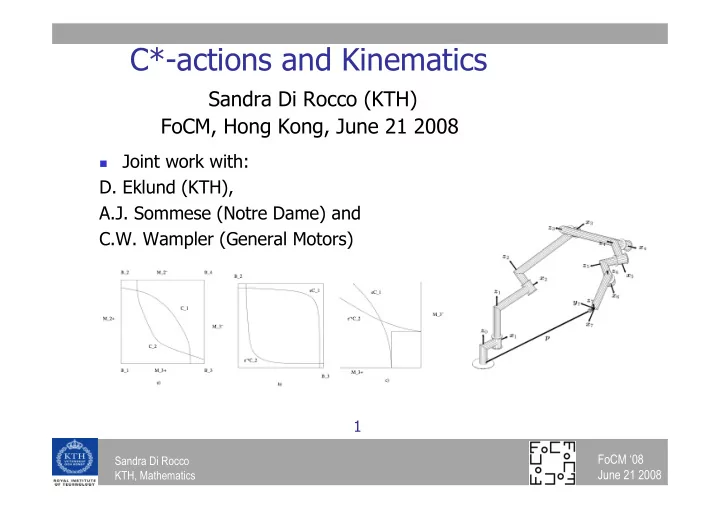

C*-actions and Kinematics Sandra Di Rocco (KTH) FoCM, Hong Kong, June 21 2008 Joint work with: D. Eklund (KTH), A.J. Sommese (Notre Dame) and C.W. Wampler (General Motors) 1 FoCM ‘08 Sandra Di Rocco June 21 2008 KTH, Mathematics
Plan: Some facts on complex manifolds with a C*-action. Intersecting two subvarieties of complementary dimension. A numerical approximation, the Intersection Algorithm. Solving the inverse kinematics problem for a general Six- Revolute Serial-Link Manipulator. 2 FoCM ‘08 Sandra Di Rocco June 21 2008 KTH, Mathematics
Complex manifolds with a C*-action Consider a non singular complex projective variety of dimension n. Suppose that it is equipped with a C*-action having a finite fixed point set. Data: 3 FoCM ‘08 Sandra Di Rocco June 21 2008 KTH, Mathematics
Complex manifolds with a C*-action The Bialynicki-Birula decomposition (1973): The space X can be decomposed in locally closed invariant subsets, in two ways: the “plus” and “minus” decomposition. There are two distinguished blocks, called the source and the sink 4 FoCM ‘08 Sandra Di Rocco June 21 2008 KTH, Mathematics
Complex manifolds with a C*-action Example: The smooth quadric hypersurface in 3-space, with an action having 4 fixed points 5 FoCM ‘08 Sandra Di Rocco June 21 2008 KTH, Mathematics
Complex manifolds with a C*-action Main idea: use the action to find numerically the intersection of two curves. How: pushing one towards the sink and the other towards the source. This will provide starting points and a homotopy to track the points back. 6 FoCM ‘08 Sandra Di Rocco June 21 2008 KTH, Mathematics
Algorithm in a toy-example Example with two curves, Y,Z in the quadric. 7 FoCM ‘08 Sandra Di Rocco June 21 2008 KTH, Mathematics
Example Locally near the other two fixed points: 8 FoCM ‘08 Sandra Di Rocco June 21 2008 KTH, Mathematics
Example In an (analytic) neighborhood of the other two points we can linearize the action. Locally the cells are translates of the coordinate axis. Intersection with the cells give start points. 9 FoCM ‘08 Sandra Di Rocco June 21 2008 KTH, Mathematics
The problem Let X be a non singular complex projective variety, with a C*- action whose fixed-set is finite. Let Y,Z be pure-dimensional subvarieties of complementary dimension. Assume (for simplicity) that they are in general position with respect to the action and they intersect transversally. Give an algorithm to approximate numerically the points of intersection. 10 FoCM ‘08 Sandra Di Rocco June 21 2008 KTH, Mathematics
The algorithm Set up: 11 FoCM ‘08 Sandra Di Rocco June 21 2008 KTH, Mathematics
The algorithm 1) 2) 12 FoCM ‘08 Sandra Di Rocco June 21 2008 KTH, Mathematics
The algorithm 3) 4) 13 FoCM ‘08 Sandra Di Rocco June 21 2008 KTH, Mathematics
The Six-Revolute Serial-Link Manipulator The most common Robot-arm 14 FoCM ‘08 Sandra Di Rocco June 21 2008 KTH, Mathematics
The Six-Revolute Serial-Link Manipulator Given p find the positions and rotation of each joint making The arm arrive at p. This problem has 16 solutions -Shown by continuation by Tsai&Morgan 1985, total degree homotopy: 256 - 1988, Li&Liang, degree 16 15 FoCM ‘08 Sandra Di Rocco June 21 2008 KTH, Mathematics
Geometric setting The solution space: The space of “special Euclidean transforms in 3-space” is identified with a non singular quadric in 7-projective space, called the Study Quadric. 16 FoCM ‘08 Sandra Di Rocco June 21 2008 KTH, Mathematics
The 6R IKP Split the problem in two 3R IKP Each 3R IKP has a 3-dimensional subspace of solutions, X,Y. The final solutions are given by intersecting X and Y. 17 FoCM ‘08 Sandra Di Rocco June 21 2008 KTH, Mathematics
The (general) 6R IKP Reduce the problem to two general 3R IKP. The intersection algorithm, in MatLab+ Bertini, takes 44 sec. to find the 16 solutions, tracking exactly 16 paths. 18 FoCM ‘08 Sandra Di Rocco June 21 2008 KTH, Mathematics
Summary A C*-action on a non singular algebraic variety, having a finite fixed-set, gives two decompositions. The decompositions have two distinguished cells: The source and the sink. Given two subvarieties of complementary dimension, by pushing one towards the source and the other towards the sink we force the intersection points to move towards certain fixed points. By homotopy continuation we can trace the intersection back and solve the intersection problem. This algorithm has natural applications in kinematics, for example it gives a new algorithm to solve a general 6R IKP. THANKS! 19 FoCM ‘08 Sandra Di Rocco June 21 2008 KTH, Mathematics
Recommend
More recommend